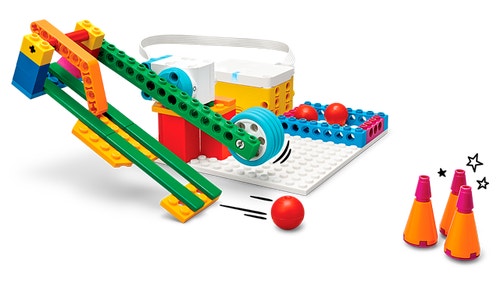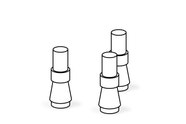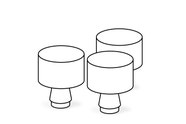Bowling Fun
Have fun with Daniel’s ten-pin bowling game! Can you bowl a strike?

Prepare
- Review the Bowling Fun lesson in the LEGO® Education SPIKE™ App.
- If you feel that it would be beneficial, pre-teach these related vocabulary words: force, modify, potential energy and ramp.
- Consider the abilities and backgrounds of all your pupils. Differentiate the lesson to make it accessible to everyone. Please refer to the Differentiation section below for suggestions on how to do this.
- If time permits, plan and facilitate the language arts extension. Please refer to the Extension section below for further information.
Engage
(Whole Class, 5 Minutes)
- Facilitate a quick discussion about the outcomes of the energy changes that occur when objects collide.
- Talk with your pupils about what happens when two or more objects collide (e.g. in ten-pin bowling, cricket, or golf).
- Ask questions like these: What will you see when two objects collide? What do you think happens to the energy of the objects when they collide?
- Introduce your pupils to the story’s main characters and the first challenge: bowling a strike.
- Distribute a brick set and a device to each group.
Explore
(Small Groups, 30 Minutes)
- Have your pupils use the LEGO® Education SPIKE™ App to guide them through their first challenge:
- Create and test the program to bowl a strike.
- Have your pupils iterate and test their models to complete the next two challenges in the app:
- Modify the program to improve the bowling game.
- Upgrade the bowling game to knock down different types of pins.
- You can find coding and building help in the Tips section below.
Explain
(Whole Class, 5 Minutes)
- Gather your pupils together to reflect on their completed challenges.
- Ask questions like these: How did you bowl a strike? How did the ball’s energy affect the bowling pins?
Elaborate
(Whole Class, 5 Minutes)
- Prompt your pupils to discuss and reflect on the energy changes that occur when objects collide.
- Ask questions like these: How do you know that two objects have collided? Why does the speed of an object affect what happens when two objects collide?
- Have your pupils tidy up their workstations.
Evaluate
(Ongoing Throughout the Lesson)
- Ask guiding questions to encourage your pupils to ‘think aloud’ and explain their thought processes and reasoning in the decisions they have made while building and programming their models.
Observation Checklist
- Measure your pupils’ proficiency in predicting the outcomes of energy changes that occur when objects collide.
- Establish a scale that suits your needs. For example:
- Requires additional support
- Can work independently
- Can teach others
Self-Assessment
Have each pupil choose the brick that they feel best represents their performance.
- Yellow: I think that I can describe how energy changes when objects collide.
- Blue: I can describe how energy changes when objects collide.
- Green: I can describe how energy changes when objects collide, and I can also help a friend to do it.
Peer Feedback
- In their small groups, have your pupils discuss their experiences working together.
- Encourage them to use statements like these:
- I liked it when you…
- I would like to hear more about how you…
Tips
Coding Tips
- After your pupils have completed their first challenge, they will be provided with a map.
- Using the map, your pupils can experiment with the available Coding Blocks to modify their programs to follow the route for the trip.




Model Tip
- After your pupils have completed their second challenge, they will be provided with three Inspiration Images and an open-ended prompt, which will help them to improve their models.
- The Inspiration Images are meant to help spark their imaginations as they experiment and change their models.




There are no specific building instructions for this challenge.
Differentiation
Simplify this lesson by:
- Selecting one Inspiration Image to help your pupils to change their models
- Experimenting with either the coding or the building
Increase the difficulty by:
- Using the Colour Sensor to start the program for the bowling ramp
- Adding obstacles that could affect the ball’s energy before it reaches the pins
Extension
- Have your pupils conduct a short research project about accessibility in public spaces, and how objects can be modified to make the space accessible to everyone.
If facilitated, this will extend beyond the 45-minute lesson.
ACELA1498
Incorporate new vocabulary from a range of sources into students’ own texts including vocabulary encountered in research
Teacher Support
The pupils will:
- Predict outcomes of the energy changes that occur when objects collide
- Observe and describe the relationship between energy and force
- Engage effectively in a range of collaborative discussions
(one for every two pupils)
- LEGO® Education SPIKE™ Essential Set
- Device with the LEGO® Education SPIKE™ App installed
Digital Technologies
ACTDIP011
Implement simple digital solutions as visual programs with algorithms involving branching (decisions) and user input.
English Language
ACELA1498
Incorporate new vocabulary from a range of sources into students’ own texts including vocabulary encountered in research.
Science
ACSSU076
Forces can be exerted by one object on another through direct contact or from a distance.




